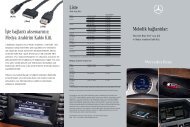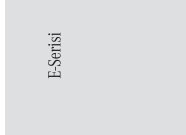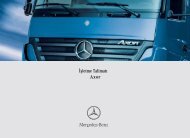Assessment - Mercedes Benz
Assessment - Mercedes Benz
Assessment - Mercedes Benz
Create successful ePaper yourself
Turn your PDF publications into a flip-book with our unique Google optimized e-Paper software.
Material Test Group<br />
28.06.2012 <strong>Mercedes</strong>-<strong>Benz</strong> Türk Istanbul
Index<br />
1. Accredited test scopes<br />
2. Metal material tests<br />
3. Non-Metal material tests<br />
Folie 2
Accredited test scopes<br />
Folie 3
Accredited test scopes<br />
1.Chemical Analysis<br />
1.1 Spectrometric (OES) elemental<br />
analysis for low alloyed steel:<br />
%C,%Si,%Mn,%P,%S,%Cr,%Mo,%Ni,%Al,%Cu,<br />
%Pb,%V,%As.<br />
2. Physical Analysis<br />
2.1 Tensile strenght tests for plate steels.<br />
EN ISO 6892-1 thickness,1-15mm<br />
2.2 Microvickers hardness tests HV0.3- HV10<br />
EN ISO 6507-1<br />
2.3 Martindale abrasion tests for fabrics DIN EN<br />
ISO 12947-2<br />
2.4 horixontal / vertical burning behaviour tests<br />
95/28EC, ECE-R 118,FMVSS302, CMVSS302<br />
2. Physical Analysis<br />
2.5 Burning behaviour drop tests<br />
95/28EC, ECE-R 118<br />
2.6 Buring behaviour tests for electircal wires<br />
ECE-R 118<br />
2.7 Determine the capability of isolution materials<br />
to repel fuel or lubricant ECE-R 118<br />
2.8 Xenontest colorfastness and ageing test for<br />
non-metal materials.<br />
(DIN EN ISO 105-B06)<br />
Folie 4
1. Chemical Analysis<br />
1.1 Spectrometric analysis<br />
- Elemental analysis for low alloyed steel<br />
were performed with ARL 3460 optic emission<br />
spectrometer (OES). The results given in % units from<br />
the computer in less then 30sec.<br />
The inspected elements are<br />
%C,%Si,%Mn,%P,%S,%Cr,%Mo,<br />
%Ni,%Al,%Cu,%Pb,%V,%As,<br />
Folie 5
2. Physical Analysis<br />
2.1 Tensile strength tests according to<br />
DIN EN ISO 6892-1 with ZWICK Z600<br />
tensile test equipment<br />
•Material Steel plates:<br />
•Thickness,1-15mm<br />
•Max. capasity 600kN<br />
•working distance max.1940mm<br />
•Working width max. 740mm<br />
2.2 Micorvickers hardness tests<br />
according EN ISO 6507-1 with ZWICK ZHV 10 test<br />
equipment. HV 0.3 - HV10<br />
Folie 6
2. Fiziksel Testler<br />
2.3 This part of IS0 12947 is applicable<br />
to the determination of the inspection<br />
interval to breakdown of specimens<br />
covering all textile fabrics including<br />
nonwovens apart from fabrics where the<br />
specifier indicates the end performance<br />
as having a low abrasion wear life. In<br />
accordance to DIN EN ISO 12947-2<br />
2.4 According to 95/28EC, ECE-R118,<br />
FMVSS302, CMVSS302 regulations<br />
determining of the horizontal and vertical<br />
burning behaviour of non-metal materials<br />
Folie 7
2. Physical tests<br />
2.5 According to 95/28EC, ECE-R118, FMVSS302,<br />
CMVSS302 regulations determining of the melting<br />
burning behaviour of non-metal materials<br />
2.6 Electric cables shall undergo the resistance to flame<br />
propagation test described in ISO standard 6722,<br />
paragraph 12. Minimum of 50 mm insulation at the top of<br />
the test sample shall remain unburned.<br />
2.7 Determining the cabability to repel fuel or lubircant of<br />
insulation materials used in the engine compartment and<br />
any seperate heating compartments.<br />
Folie 8
2. Physical tests<br />
2.8 XENON TestSpecification of colour fastness (to light at high<br />
temperatures) and ageing (to light at high temperatures) to artificial light at<br />
high temperatures in accordance with DIN EN ISO 105-B06:<br />
.Fastness to light at high temperatures<br />
End point determination: Exposure up to DE 4.3+/-0.4 of fastness type 6<br />
(irradiated/covered). Color measurement of the fastness type using a white reference<br />
tile as an underlay.<br />
<strong>Assessment</strong>: Comparison of irradiated specimen with original specimen with<br />
illuminant type D65. <strong>Assessment</strong> with blue scale (fastness types)<br />
Determination of ageing to light at high temperatures<br />
End point determination: as for fastness to light at high temperatures, but involving<br />
several, successive cycles.<br />
<strong>Assessment</strong>: Comparison of irradiated specimen with original<br />
specimen with illuminant type D65. <strong>Assessment</strong> with grey scale<br />
to DIN EN 20105-A02 Common applications include:<br />
• Automotive coatings, fabrics and plastics<br />
• Packaging, Paints, coatings and pigments, Plastics, Window<br />
profiles<br />
• Textiles including industrial and geotextiles<br />
Folie 9
Metaltests<br />
Folie 10
Index<br />
1 Chemical Analysis<br />
1.1 Carbon/Sulphur Determination<br />
1.2 Spectrometric analysis<br />
2 Physical Characteristics<br />
2.1 Tensile strength tests<br />
2.2 Bending and compression tests<br />
2.3 ERICHSEN cupping tests<br />
2.4 Welding control<br />
2.5 Welding and material defect<br />
control<br />
with penetrant liquid<br />
2.6 Spot welding control<br />
2.7 Hardness Tests<br />
3 Metallography<br />
3.1 Analysis with metallurgia microscope<br />
3.2 Analysis with stereo microscope<br />
4 Welding technique<br />
4.1 Welding training according to DIN EN<br />
287<br />
4.2 Welding control according to DIN EN<br />
5817<br />
4.3 Parameter adjustment of welding<br />
equipment<br />
4.3 Consultant services for suppliers<br />
5 Sample preparation<br />
5.1 For metallography and hardness tests<br />
5.2 for spectrometer and tensile stregth<br />
analysis<br />
Folie 11
1. Chemical Analysis<br />
1.1 Carbon / Sulphur determination in<br />
ferrous alloys<br />
•Analysis performed with LECO<br />
C-S 230<br />
•% C and % S amount is measured with<br />
0,00001 accuracy<br />
1.3 Spectrometric analysis<br />
- Ferrous Fe alloys<br />
- Aluminium Al alloys<br />
- Coopfer Cu alloys<br />
- Zinc Zn alloys<br />
Are conducted with ARL 3460 optic emission<br />
spectrometer. Analysis are performed in less than<br />
one minute and results are given by the computer.<br />
Folie 12
2. Physical Analysis<br />
2.1 Tensile, Bending and Compression tests<br />
Tests are performed according EN ISO6892<br />
with ZWICK Z600 tensile testing machine.<br />
For metallic materials<br />
Mills, pipes and metal plates<br />
•Max.600kN capasity<br />
•1940mm working distance<br />
•740mm max. Working width<br />
2.2 ERICHSEN Cupping Test<br />
Sheet Metal Test is with ERICHSEN 102 Deep Drawing Cup according to DIN50101.<br />
Folie 13
2. Physical Characteristics<br />
2.3 Welding Control<br />
•Destructive<br />
•Non-destructive (with penetrant liquids)<br />
•Welding and material defect control with penetrant liquid<br />
• Destructive<br />
• Ultrasonic detector<br />
2.4 Spot Welding Control<br />
Non-destructive<br />
Folie 14
2. Physical Characteristics<br />
2.5 Hardness Tests<br />
•Result units in Rockwell, Brinell and Vickers<br />
•Pressure force between 20-3000 kg<br />
•For all metallic material hardness tests<br />
Hardness of the samples prepared according to DIN Standarts<br />
is measured at Duravision300 hardness tester in accordance with<br />
the standarts given below:<br />
Brinell HB hardness: DIN 50 351<br />
Vickers HV hardness: DIN 50 133<br />
Rockwell HRC, HRB, HRA hardness: DIN 50 103<br />
Folie 15
3. Metallography<br />
Microstructure, welding and fracture<br />
analysis are conducted by the equipment<br />
given below.<br />
•Inverted Research Metallurgica<br />
microscope<br />
OLYMPUS PMG 3<br />
•Stereo Mikroscope OLYMPUS SZH 10<br />
•Visualizer WOLFVİSİON VZ-9<br />
Folie 16
4. Welding Technique<br />
At the Welding Training Center<br />
• MIG/MAG and TIG training in accordance with DIN EN 287 is conducted for welders<br />
and trainees at the production, as well as for the welders of suppliers<br />
• Parameter adjustments of welding machines in production are inspected<br />
• In case of problems consultant services to suppliers are offered<br />
Folie 17
5. Sample Preparation<br />
5.1 For metallography and hardness tests<br />
• Cutting<br />
• Precision cutting<br />
• Hot mounting<br />
• Polishing<br />
Folie 18
5. Sample Preparation<br />
5.2 For wet chemical analysis and<br />
spectrometer<br />
• Analytical balance for weight<br />
measurement of samples<br />
( 0.0001g accuracy)<br />
• Analytical balance for weight<br />
measurement of chemicals<br />
( 0. 01g accuracy)<br />
•Drilling machine<br />
Folie 19
5. Sample Preparation<br />
5.2 For wet chemical analysis and<br />
spectrometer<br />
• Grinding machine for<br />
spectrometer sample preparation<br />
• Furnace<br />
• Fine grinding machine for<br />
spectrometer sample preparation<br />
• Drying oven<br />
Folie 20
Non-Metaltests
Services Offered<br />
1. Chemical Analysis<br />
1.1 Gravimetric Analysis Determination of filler<br />
content<br />
1.2 Pyrolysis testing<br />
1.3 Determination of glasfiber amount<br />
2. Physical Tests<br />
2.1 Shore A / Shore D hardness measurement<br />
2.2 Ball indentation hardness test<br />
2.3 Compression set<br />
2.4 Tension set<br />
2.5 Tensile strength / Elongation at break<br />
2.6 Tear propagation resistance<br />
2.7 Peeling adhesion test<br />
2.8 Peening pressure<br />
2.9 Jib adhesion strength<br />
2. Physical Tests<br />
2.13 Resistance to friction<br />
2.14 Determination of impact properties<br />
2.15 Determination of Vicat softening temperature<br />
2.16 Density<br />
2.17 Mass per unit area<br />
2.18 Water content<br />
2.19 Refractive index<br />
2.20 Kinematic viscosity measurement - Ubbelohde<br />
method<br />
2.21 Flash and fire point<br />
� Cleveland Method<br />
� Abel-Pensky Method<br />
2.22 Boiling point<br />
3. Weathering Test<br />
2.10 Bending strength / bending at maximum bending 3.1 Wash-out discolouration<br />
force<br />
3.2 Ozone resistance<br />
2.11 Stitch pull strength<br />
2.12 Shearing strength<br />
3.3 Low/high temperature behaviour<br />
Folie 22
Services Offered<br />
3. Weathering Test<br />
3.4 Ageing tests<br />
� Hot air ageing<br />
� Testing in ASTM oils<br />
� Testing with coolants (antifreeze)<br />
� Testing in fuels<br />
� Ageing cycle<br />
� Water storage<br />
� Xenotest (DIN EN ISO 105-B06)<br />
4. Instrumental Analysis<br />
4.1 FTIR –Spektrophotometer analysis<br />
4.2 Gas chromatography analysis<br />
4.3 potansiometric titration analysis<br />
4.4 DSC analysis<br />
4.5 TGA analysis<br />
Folie 23
1. Chemical Analysis<br />
1.1 Gravimetric Analysis: Determination<br />
of filler content. The method according to<br />
the standarts DIN 53568 / DIN 53395 /<br />
DIN EN 60 is used for determining the<br />
residue on ignition produced by plastics,<br />
rubber and elastomers without pretreatment.<br />
1.2 Pyrolysis testing<br />
Determination of plastic materials with the<br />
pyrolysis technic and inspecton with FTIR<br />
1.3 Quantative determination of glassfiber in reinforced<br />
plastics according to DIN EN 60.<br />
Folie 24
2. Physical Tests<br />
2.1 Shore A/Shore D hardness<br />
•Plastics<br />
•Rubber<br />
is measured according to DIN 53 505 with Zwick<br />
7206 hardness tester.<br />
2.2 Ball indentation hardness test<br />
Measurements according to DIN EN ISO 2039-1 with<br />
Zwick 3106 hardness tester.<br />
2.3 Compression set<br />
•Rubbers<br />
•PU (Polyurethane materials)<br />
is determined according to DIN ISO 815 and Daimler-<br />
<strong>Benz</strong> specifications.<br />
Folie 25
2. Physical Tests<br />
2.4 Tension set<br />
Tension set of rubber is determined according<br />
to DIN ISO 2285 and Daimler-<strong>Benz</strong><br />
specifications.<br />
2.5 Tensile strength / Elongation at break<br />
•rubber<br />
•plastics<br />
•textile<br />
•1K-PUR adhesives<br />
•Floor covering<br />
•Leather and artifical leather<br />
•Sticky bands<br />
DIN EN ISO 527-1/2/3<br />
DIN EN ISO 1798<br />
DIN 53328<br />
DIN EN ISO 13934-1<br />
Folie 26
2. Physical Tests<br />
2.6 Tear propagation resistance<br />
•Rubber<br />
•Textile<br />
•Leather and artificial leather<br />
is determined with Zwick 1141.<br />
Tensile Testing Machine following VDA675210,<br />
VDA 675211B, DIN 53 356, DIN 57859-5<br />
and DIN EN ISO03377-1/2.<br />
2.7 Peeling adhesion test<br />
•Tissue reinforced elastomers<br />
•Textile reinforced hoses<br />
according to DIN 53 357 and DIN<br />
53 530 with ZWICK Z010 Tensile<br />
Testing Machine.<br />
Folie 27
2. Physical Tests<br />
2.8 Peening pressure<br />
Measurement of peening pressure of textile reinforced hoses<br />
according to DIN53758 with the specified apparatus.<br />
2.9 Jib adhesion strength<br />
Determination of adhesion strength of rubber containing jibs<br />
according to DIN ISO 6133 and Daimler-<strong>Benz</strong> specifications.<br />
2.10 Bending strength / bending at maximum bending force<br />
•Plastic<br />
•Plywood<br />
is determined according to DIN 53 452 and DIN EN 310 with ZWICK Z010.<br />
2.11 Stitch pull strength<br />
The stitch pull strength of leather, artificial leather and similar materials<br />
is determined according to DIN EN ISO 13936-2<br />
with ZWICK Z010 Tensile Testing Machine.<br />
Folie 28
2. Physical Tests<br />
2.12 Shearing strength<br />
•Labels<br />
•Sticky bands<br />
is determined according to DIN 53 278 and DIN 50 017.<br />
2.13 Resistance to friction<br />
•Textile<br />
•Leather and artifical leather<br />
•Floor coverings<br />
according to DIN 54 021 with Crockmeter.<br />
2.14 Darbe Test cihazı<br />
This part of ISO 179/180 specifies a method for determining the<br />
Charpy/Isod/Dynstat impact strength of plastics under defined<br />
conditions. A number of different types of specimen and test<br />
configurations are defined. Different test parameters are specified<br />
according to the type of material, the type of test specimen and the<br />
type of notch.<br />
Folie 29
2. Physical Tests<br />
2.15 This international standart En ISO 306 specifies 4 methods for<br />
the determination of the Vicat softening temperature ( VST) of<br />
thermoplastic materilias.<br />
-- Method A50 using a force of 10 N and a heating rate of 50°C/h<br />
-- Method B50 using a force of 50 N and a heating rate of 50°C/h<br />
-- Method A120 using a force of 10 N and a heating rate of 120°C/h<br />
-- Method B120 using a force of 50 N and a heating rate of 120°C/h<br />
The methods specified are applicable only to thermo-<br />
Plastics, for which they give a messure of the temperature<br />
at which the thermoplastics starts to soften rapidly.<br />
The temperature at which a standart indenting tip with a<br />
Flat point penetrates 1mm into the surface of a plastic<br />
Test specimen is determined.<br />
Folie 30
2. Physical Tests<br />
2.16 Density<br />
•Density of solids is determined according<br />
to DIN EN ISO 1183 and DIN 53 420.<br />
•Density of liquids is determined according to DIN 51 757<br />
with PAAR Density meter.<br />
2.17 Mass per unit area<br />
•Textile<br />
•Leather and artifical leather<br />
Determined according to DIN EN 12127,DIN 53 352,<br />
DIN ISO 536 and DIN ISO 2420.<br />
2.18 Water content<br />
•Plastic<br />
•Wood and plywood<br />
Determined according to DIN 50 011, DIN 53 304, DIN 52 183<br />
and DIN 52375.<br />
Folie 31
2. Physical Tests<br />
2.19 Refractive index<br />
Refractive index is determined according to DIN 51<br />
423 with Atago refractometer.<br />
2.20 Kinematic viscosity measurement –<br />
(Ubbelohde method Measurement) of kinematic<br />
viskosity of automotive oils according to DIN 51<br />
562 with Schott AVS - 440<br />
capillary viscosimeter.<br />
Folie 32
2. Physical Tests<br />
2.21 Flash/fire point<br />
of automotive oils is determined according to<br />
a) Cleveland Method DIN EN ISO 2592<br />
b) Abel - Pensky Method DIN 51 755<br />
of solids is determined according to DIN 53 479<br />
and DIN 53 420<br />
of liquids is determined according to DIN 51 757<br />
with PAAR Density meter<br />
2.22 Destillation<br />
Distillation range of petroleum products is measured<br />
according to DIN 51 751 with Petrotest distillation<br />
apparatus.<br />
Folie 33
3. Weathering Test<br />
3.1 Wash-out discolouration<br />
Wash-out discolouration of rubber is determined<br />
according to VDA 675 242.<br />
3.2 Ozone resistance<br />
Ozone resistance of rubber is determined<br />
According to VDA 675 311 at Hampden<br />
Ozone Testing Cabinet.<br />
3.3 Low / High temperature behaviour<br />
Hot storage behaviour and<br />
the change ofDimensions is<br />
determined according to<br />
DIN 53 497 and DIN 53 377.<br />
Folie 34
3. Weathering Test<br />
3.4 Ageing tests<br />
•Hot air ageing<br />
of rubber and adhesives according to DIN 53 508, VDA 675 310<br />
and Daimler-<strong>Benz</strong> specifications<br />
•Testing in ASTM mineral oils<br />
of rubber according to DIN 53 521<br />
•Testing with coolants (antifreeze)<br />
of rubber according to VDA 52 103<br />
•Testing with test fuels<br />
of rubber according to DIN 51 604 and VDA 675 302<br />
•Ageing cycle<br />
of adhesives in alternating ageing environments e.g. at<br />
room temperature, in hot and cold environment at<br />
humidity cabinet.<br />
•Water storage<br />
of plywood and adhesives according to Daimler-<strong>Benz</strong><br />
specifications.<br />
•Xenotest (DIN EN ISO 105-B06)<br />
Folie 35
4. Instrumental Analysis<br />
4.1 FTIR Spectrophotometer Analysis<br />
•Qualitative/quantitative analysis of rubber, plastics, textile, adhesives<br />
and oil are conducted by Perkin-Elmer FTIR Spectrum One instrument.<br />
•Direct analysis of small-sized materials without pretreatment is<br />
conducted with Split-Pea measurement unit.<br />
4.2 Gas chromatography Analysis<br />
Qualitative/quantitative analysis of volatile organic materials<br />
(particularly solvents) is conducted with Perkin-Elmer Autosystem GC.<br />
4.3 Potansiometric titration analysis<br />
•Conducted by Mettler DL 70 Potansiometric titration instrument<br />
•In automotive oils, determination of total base number according to<br />
DIN ISO 3771<br />
•Total acid number according to ASTM D 664<br />
•Determination of water content in engine oil and solvents according to<br />
Karl-Fischer method DIN ISO 3733<br />
Folie 36
4. Instrumental Analysis<br />
4.4 DSC Analysis<br />
DSC Analysis performaned with Netzsch DSC 204.<br />
Determination of polymetric materials with regard to:<br />
•Glass transition temperature<br />
•melting range<br />
•degree of crystallinity<br />
•heat capacity<br />
•oxidation and thermal stability<br />
4.5 TGA analysis<br />
•Materials are broken down into their constituents by heat<br />
•Qualitative/quantitative analysis are conducted with Netzsch TG<br />
209.<br />
Folie 37










